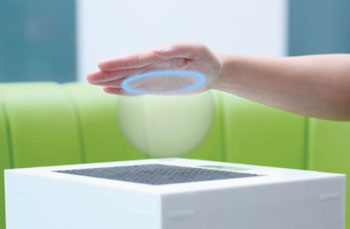Holographic Haptic Shapes Realized Using Ultrasound
By LabMedica International staff writers
Posted on 18 Dec 2014
Technology has quickly changed recently with touch feedback, known as haptics, being used in rehabilitation, entertainment, and even surgical training. New research, using ultrasound, has created an invisible three-dimensional (3-D) haptic shape that can be both seen and felt.Posted on 18 Dec 2014
The study’s findings, published in the December 2014 issue of ACM Transactions on Graphics, and which was presented at the SIGGRAPH Asia 2014 Conference, held December 3–6, in Shenzhen (China), demonstrated how a holographic technology has been created to produce 3-D shapes that can be felt in mid-air.

Image: Ultrasound is focused to create the shape of a virtual sphere. (Photo courtesy of Bristol Interaction and Graphics group, University of Bristol).
The research, led by Dr. Ben Long and colleagues Prof. Sriram Subramanian, Sue Ann Seah, and Tom Carter from the University of Bristol’s (UK) department of computer science, could change the way 3D shapes are used. The new technology could enable surgeons to study a computed tomography (CT) scan by enabling them to feel a disease, such as a tumor, using haptic feedback.
The technology uses ultrasound, which is focused onto hands above the device and that can be felt. By focusing complicated patterns of ultrasound, the air disturbances can be seen as floating 3-D shapes. The investigators have visually demonstrated the ultrasound patterns by directing the device at a thin layer of oil so that the depressions in the surface can be seen as spots when lit by a lamp. The system generates an invisible 3-D shape that can be added to 3-D displays to create something that can be seen and felt. The researchers have also shown that users can match a picture of a 3-D shape to the shape created by the system.
Dr. Ben Long, research assistant from the Bristol Interaction and Graphics (BIG) group in the department of computer science, said, “Touchable holograms, immersive virtual reality that you can feel and complex touchable controls in free space, are all possible ways of using this system. In the future, people could feel holograms of objects that would not otherwise be touchable, such as feeling the differences between materials in a CT scan or understanding the shapes of artefacts in a museum.”
Related Links:
University of Bristol




 assay.jpg)









